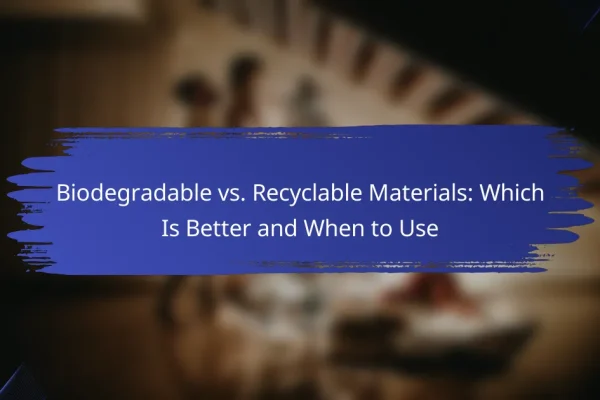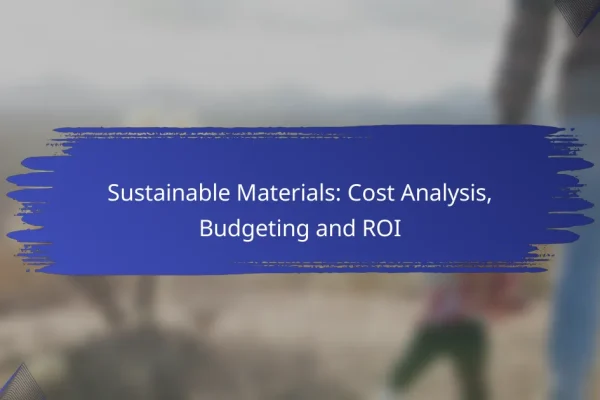What are eco-friendly materials for green businesses?
Eco-friendly materials are sustainable resources that minimize environmental impact and promote sustainability in business practices. These materials are often renewable, recyclable, or biodegradable, making them ideal choices for companies aiming to reduce their carbon footprint.
Bamboo
Bamboo is a fast-growing grass that can be harvested sustainably, making it an excellent eco-friendly material. It is strong, lightweight, and versatile, suitable for products ranging from furniture to textiles. When choosing bamboo products, look for those certified by organizations like the Forest Stewardship Council (FSC) to ensure responsible sourcing.
Recycled plastics
Recycled plastics are materials repurposed from post-consumer waste, reducing the need for new plastic production. They can be used in various applications, including packaging, textiles, and construction materials. Businesses should prioritize products made from a high percentage of recycled content and ensure they are recyclable themselves to close the loop on plastic waste.
Organic cotton
Organic cotton is grown without synthetic pesticides or fertilizers, making it a healthier choice for the environment and farmers. It requires less water than conventional cotton and promotes biodiversity. When sourcing organic cotton, look for certifications like Global Organic Textile Standard (GOTS) to verify its organic status.
Hemp
Hemp is a highly sustainable crop that grows quickly and requires minimal resources, including water and pesticides. It can be used for textiles, paper, and biodegradable plastics. Businesses should consider hemp products for their durability and low environmental impact, and look for suppliers who practice sustainable farming methods.
Reclaimed wood
Reclaimed wood is salvaged from old buildings, furniture, or other structures, giving it a second life while reducing deforestation. It adds unique character to products and is often more durable than new wood. When using reclaimed wood, ensure it is treated and sourced responsibly to avoid potential issues with contaminants or structural integrity.
How can businesses implement eco-friendly materials?
Businesses can implement eco-friendly materials by assessing their current usage, sourcing from sustainable suppliers, and educating their staff on environmentally friendly practices. This approach not only reduces environmental impact but can also enhance brand reputation and customer loyalty.
Conduct a material audit
A material audit involves reviewing all materials currently used in production and operations to identify those that are harmful to the environment. This process helps businesses understand their ecological footprint and pinpoint areas for improvement.
During the audit, categorize materials based on their sustainability, recyclability, and source. Focus on eliminating or replacing high-impact materials with eco-friendly alternatives, such as biodegradable plastics or recycled paper.
Source from sustainable suppliers
Choosing sustainable suppliers is crucial for ensuring that the materials used are environmentally friendly. Look for suppliers who adhere to recognized sustainability certifications, such as FSC for wood products or GOTS for textiles.
Establishing partnerships with local suppliers can also reduce transportation emissions and support the local economy. Evaluate suppliers based on their environmental practices and commitment to sustainability to make informed choices.
Train staff on eco-friendly practices
Training staff on eco-friendly practices is essential for the successful implementation of sustainable materials. Provide workshops and resources that highlight the importance of sustainability and how employees can contribute.
Encourage staff to adopt practices such as reducing waste, recycling, and choosing sustainable options in their daily tasks. Regularly update training materials to reflect new eco-friendly innovations and practices, ensuring ongoing awareness and engagement.
What are the benefits of using eco-friendly materials?
Using eco-friendly materials offers numerous advantages, including reduced environmental impact, cost savings over time, and improved public perception. These materials often lead to sustainable practices that benefit both businesses and the planet.
Reduced carbon footprint
Eco-friendly materials typically have a lower carbon footprint compared to conventional options. For instance, materials like bamboo and recycled plastics require less energy to produce and transport, contributing to lower greenhouse gas emissions. Businesses can significantly decrease their overall carbon output by choosing these sustainable alternatives.
To maximize the benefits, companies should conduct a lifecycle assessment of their materials. This assessment helps identify the carbon emissions associated with each stage, from production to disposal, allowing for informed decisions that further minimize environmental impact.
Enhanced brand reputation
Adopting eco-friendly materials can greatly enhance a company’s brand reputation. Consumers are increasingly favoring brands that demonstrate a commitment to sustainability, often leading to increased customer loyalty and sales. For example, companies that use organic cotton or recycled materials in their products can attract environmentally conscious consumers.
To leverage this benefit, businesses should actively communicate their sustainable practices through marketing and social media. Transparency about sourcing and production methods can further strengthen brand trust and appeal to a broader audience.
Compliance with regulations
Using eco-friendly materials can help businesses comply with environmental regulations that are becoming more stringent worldwide. Many countries have implemented laws aimed at reducing waste and promoting sustainable practices, making it essential for companies to adapt. For instance, the European Union has set ambitious targets for reducing plastic waste, encouraging the use of biodegradable materials.
Companies should stay informed about local regulations and industry standards to ensure compliance. Regular audits and updates to sourcing practices can help avoid penalties and enhance operational sustainability.
What are the costs associated with eco-friendly materials?
The costs associated with eco-friendly materials can vary significantly based on the type of material and its application. While the initial purchase price may be higher than conventional options, many eco-friendly materials can lead to savings over time through energy efficiency and reduced waste.
Initial investment vs. long-term savings
Investing in eco-friendly materials often requires a higher upfront cost, which can deter some businesses. However, these materials typically offer long-term savings through lower energy bills, reduced maintenance costs, and potential tax incentives. For instance, energy-efficient insulation may cost more initially but can save hundreds of dollars annually on heating and cooling.
Consider the lifecycle costs when evaluating eco-friendly materials. While the initial investment may seem steep, the durability and efficiency of these materials can lead to significant savings over their lifespan, making them a financially sound choice in the long run.
Price comparison with conventional materials
When comparing the prices of eco-friendly materials to conventional options, it is essential to look at both the initial costs and the long-term benefits. Eco-friendly materials can range from 10% to 50% more expensive than traditional materials, depending on the type and sourcing. For example, bamboo flooring may cost more than laminate but offers greater durability and sustainability.
It’s also important to factor in potential savings from reduced energy consumption and maintenance. While the sticker price may be higher, the overall cost-effectiveness of eco-friendly materials often makes them a better investment over time. Businesses should analyze their specific needs and calculate the total cost of ownership to make informed decisions.
How to choose the right eco-friendly materials?
Choosing the right eco-friendly materials involves evaluating their environmental impact, durability, and local availability. Prioritize materials that minimize harm to the planet while meeting your project’s specific needs.
Assess environmental impact
To assess the environmental impact of materials, consider their life cycle from production to disposal. Look for certifications such as FSC for wood or Energy Star for appliances, which indicate sustainable practices.
Evaluate the carbon footprint associated with the material’s production and transportation. For instance, locally sourced materials typically have a lower carbon footprint compared to those imported from distant locations.
Evaluate durability and performance
Durability is crucial for eco-friendly materials, as longer-lasting products reduce waste. Assess how well the material performs under expected conditions, such as moisture resistance for building materials or wear resistance for textiles.
Consider the maintenance requirements of the materials. Some eco-friendly options may need more upkeep, which can offset their environmental benefits over time. For example, bamboo flooring is durable but may require specific cleaning products to maintain its appearance.
Consider local availability
Local availability of eco-friendly materials can significantly influence your choice. Sourcing materials from nearby suppliers not only supports the local economy but also reduces transportation emissions.
Research local suppliers and manufacturers who specialize in sustainable products. This can include reclaimed wood, recycled metals, or organic textiles. Engaging with local businesses may also provide insights into the best practices for using these materials effectively.
What are examples of successful green businesses?
Successful green businesses utilize eco-friendly materials and sustainable practices to reduce their environmental impact while achieving profitability. Companies like Patagonia, Tesla, and Seventh Generation exemplify how integrating sustainability into their core operations can lead to both financial success and positive ecological outcomes.
Patagonia
Patagonia is a leader in sustainable outdoor apparel, known for its commitment to using recycled materials and organic cotton. The company actively promotes environmental activism and encourages customers to repair and recycle their gear, fostering a culture of sustainability.
Tesla
Tesla revolutionizes the automotive industry with its electric vehicles, which aim to reduce reliance on fossil fuels. By focusing on renewable energy sources and innovative battery technology, Tesla not only provides eco-friendly transportation but also contributes to the growth of sustainable energy infrastructure.
Seventh Generation
Seventh Generation specializes in eco-friendly household products, using plant-based ingredients and recyclable packaging. The company emphasizes transparency in its supply chain and aims to minimize its carbon footprint, appealing to environmentally conscious consumers.










